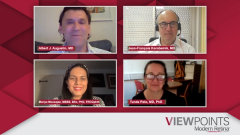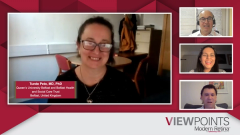
Future Gene Therapy for Inherited Retinal Disease
Dr Mariya Moosajee comments on the next generation of gene therapy for inherited retinal disease and highlights various systems under investigation.
Episodes in this series

Albert J. Augustin, MD: Dr Moosajee, can you talk more in depth about gene therapy in retinal disease? I would also like you to address virus and nonvirus approaches; vectors and nonvectors.
Mariya Moosajee, MBBS, BSc, PhD, FRCOphth: Absolutely. The gene therapy field for hereditary retinal disorders is vast. There are hundreds of trials underway for this, and now the most common vector system that we use is the adeno-associated virus [AAV]. There are gene therapy trials for achromatopsia: CNGA3, CNGB3, X-linked RP [retinitis pigmentosa]—RPGR is the main genetic cause there. Choroideremia has reached phase 3 and we’re waiting to hear the results of that. These adeno-associated viral vectors have a size limit of the gene that it can accommodate. It can accommodate genes that are essentially less than 4000 bases in size. The smaller genes are fine, but you start to get in trouble with genes that are bigger than that, that are also common causes of these retinal degenerations. For example, ABCA4; USH2A, which is the most common cause for Usher syndrome type 2, but also one of the most common causes of nonsyndromic retinitis pigmentosa, and that gene is something in the region of 18,000 bases in size. How do we then package these genes to deliver it back into the retina so that we can potentially apply this to more people? There are now a lot of studies going into developing dual AAV vectors whereby we split the gene into components and put them into individual AAV vectors with a linker so that, when it’s translated, you end up forming the complete cDNA [complementary DNA] that can be translated into a protein.
They are now in the development of these nonviral gene therapy vectors. One is a DNA plasmid that has a component called a scaffold matrix attachment region; it essentially will allow any sized gene to be carried, even portions of chromosomes, but this can easily accommodate the USH2A gene. These viral vectors are still in preclinical development and have gotten into nonhuman primates as well. However, they are showing relatively long expression—up to a year in mouse studies—and good expression of the protein in the retinas following subretinal injection. There are pros and cons to these new types of vectors. The con is that it doesn’t have the infective capability of a virus. We may need to start to use some of the devices that you talked about, like the microneedles or micro-electroporation systems that you’re developing for AMD [age-related macular degeneration], etc, to help these vectors enter into photoreceptors. The pros are that it can carry a gene of any size. They don’t have any viral components, so you’re going to reduce your chance of an immune response. They don’t integrate into the genome, so you reduce your chances of incisional mutagenesis. These specific components, like these S/MARs [scaffold/matrix attachment regions], which are naturally found within our own chromatin that help it to bind, prevent these vectors from being silenced and allow them to replicate extra chromosomally. These are coming into the future that may be the next generation of gene delivery vehicles as we go forward.
Albert J. Augustin, MD: Thank you. This was very interesting. The nonviral vectors have a better safety profile and larger cargo capacity, and they have the potential for repeated administration. Sooner or later, if we can overcome the major drawbacks, maybe nonviral vectors will be available, at least for retinal diseases. Do you have experience with the first retinal gene therapy, the Luxturna from Spark Therapeutics?
Mariya Moosajee, MBBS, BSc, PhD, FRCOphth: Yes. This is the adeno-associated viral vector that has now been approved by the FDA and the European Medicines Agency. It is approved by our NHS [National Health Service] and is available to patients, and there are sites all over the world offering this. So far, we have seen positive results. This viral vector was approved on the multi-luminance mobility maze test, where we classically see the patient at baseline. Then a year after treatment, where they’re able to navigate through the maze at 1 lux level successfully in a short period of time. In the UK [United Kingdom], my experience with pediatric patients and adults who have now had this, we are seeing a stability, if not improvement, in the children with their visual acuity and their vision in dim light, and also in improving navigational vision for older patients. The hope is that if we can also potentially deliver these genes through intravitreal, we might reach more parts of the retina because, at the moment, we’re just going for the area where we apply the bleb, and there are still islands of retina in the periphery that would be beneficial if we could treat these with the gene therapy. There is still a lot of work to do and a lot of progress to be made in general in trying to optimize the results of these gene therapies.
Transcript edited for clarity.
Newsletter
Get the essential updates shaping the future of pharma manufacturing and compliance—subscribe today to Pharmaceutical Technology and never miss a breakthrough.

















































